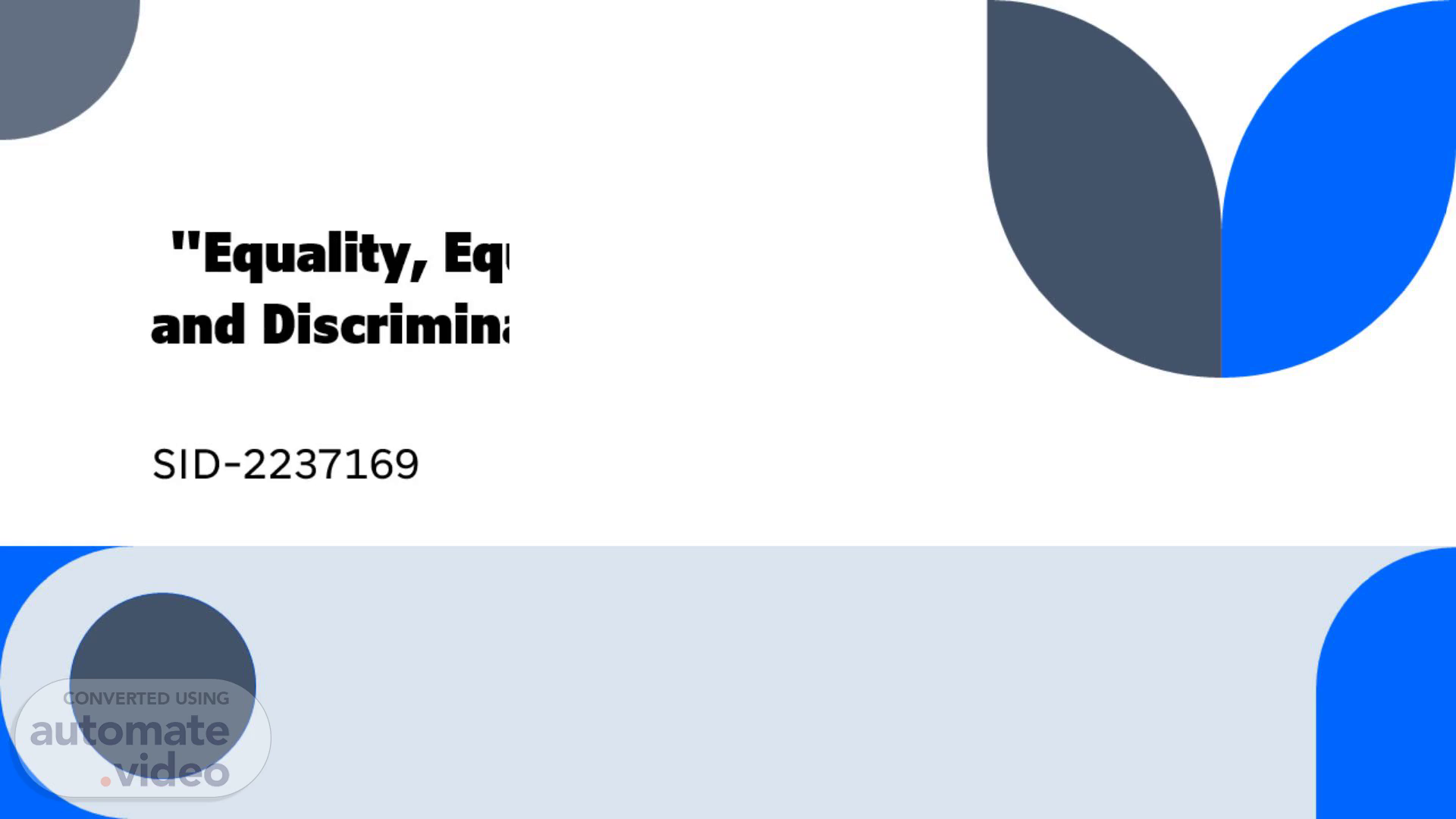Scene 1 (0s)
"Equality, Equity, Prejudice, and Discrimination".
Scene 2 (7s)
Introduction. "What Are Equality, Equity, Prejudice, and Discrimination?".
Scene 3 (15s)
[Audio] Acquittance with these ideas is important when it comes to the resolution of social issues. Equality in handling subordinates allows everyone to be treated in a similar manner, while equity established support based on the demands. It should be noted that a prejudice is an attitude, while discrimination is the unfavorable treatment that is regarded as bias. An understanding of the distinctions between these terms allows for formulations of more equal policies and strategies in an attempt to bring about equal environments..
Scene 4 (45s)
Equality. 10/9/2021. PRESENTATION TITLE. 4.
Scene 5 (52s)
[Audio] Equality means making every person equal as far as the chances of getting something important are concerned, but it doesn't categorically look at the conditions of the person. As reasonable as this seems on the first sight, it presupposes that people begin from similar positions, and thus cyclical discrimination is maintained. For instance, they assign the same textbook for every student; this fails to capture students who require more attention (Fenner, 2020)..
Scene 6 (1m 23s)
Equity. 10/9/2021. PRESENTATION TITLE. 6.
Scene 7 (1m 31s)
[Audio] While equity is all about equal rights, it does not mean equal treatment. It appreciates the fact that people have their unique requirements met depending on the available tools. For instance, offering special classes to the student to remedy the poor grades will enable them get the same results as other students. While it might mean that everyone gets equal opportunities or resources, equity means everyone has what they need to get the job done..
Scene 8 (1m 58s)
Prejudice. 8.
Scene 9 (2m 5s)
[Audio] Bias can be defined as judging a person or separating them into a group based on assumptions made on them without actually meeting them. These judgments are not oriented in facts but in the assumptions that refer to identity. For instance, beliefs that a person cannot be a leader because of being young or a woman closes chances and perpetuates margins..
Scene 10 (2m 29s)
Discrimination.
Scene 11 (2m 35s)
[Audio] Discrimination then refers to top down prejudiced beliefs are translated into unfair prejudice. It as implies acts that seek to harm other people through discriminative characteristics such as race, gender, age and others. For instance, failure to offer an employment opportunity to a particular candidate because of his or her ethnic origin is discrimination. Prejudice means previous judgment while discrimination is an action towards enforcing previous prejudice in such a way that discriminant knows it is wrong..
Scene 12 (3m 10s)
"Micro-Level Case Study: Gender Bias in Hiring (UK-Based)".
Scene 13 (3m 20s)
[Audio] In UK, all female employees in male dominated fields such as engineering and finance experience gender discrimination when it come to recruitment and promotion. The Employment Human Rights Commission (EHRC) demonstrated in their report of 2018 that women actually receive the same qualifications with their male counterparts, but they are not promoted to senior roles as often as men (EHRC, 2018). This leads to difference of pay between male and female, few female promotions, and representation of women in executive committees..
Scene 14 (4m 0s)
Macro-Level Case Study: Gender Inequality in the Global Film Industry".
Scene 15 (4m 9s)
[Audio] The #MeToo movement shed the light on the systematical gender injustice in Hollywood as the quantity of movies is still small with women, minorities or lead roles, as well directing and producing positions. Geena Davis Institute (2020) database shows that women's representation in movies is very low, and more so the representation of women of colour: Women were only 34% of speaking characters in films and only 8% of directors. Of these discrepancies entails questions of wage inequity and minimal promotion, stifering women's representation within the industry..
Scene 16 (4m 52s)
Solutions to Address Micro & Macro Gender Inequality.
Scene 17 (4m 59s)
[Audio] To mitigate gender bias in employment, the following steps should be taken; Promotion of quotas and the technique known as blind hiring in the company. The film industry should adopt policies that support gender diversity, equality or pay equality, and encourage the promotion of women's filmmaker mentorship. Only by including and synthesizing knowledge from busines;, political science, and postcolonial theory we will be able to achieve lasting change and improve gender practices and equality in positions and creative professions for women..
Scene 18 (5m 35s)
Conclusion. 10/9/2021. PRESENTATION TITLE. 18.
Scene 19 (5m 41s)
[Audio] Equality, although a laudable goal has to be surpassed if we want to move society to one where everyone has an equal chance. It is not enough to promote equality; it means recognition of the difficulties and working through them for the members of the mentioned several groups. It is crucial to eliminate prejudice and discrimination on all levels of analysis; individual, organizational, and societal to design environments that are fair to person and group..
Scene 20 (6m 12s)
References:. [image] https:iiwww.equalityhumanriqhts.com : https:/twww.aioq.orq/articIe/S0002- https:/twww.researchqate.net/profiIe/JiIlian- Fish/pubIicationi339240954 Racism Discrimination and Preiudice/Iinks/5e45a7c52 99bf1 cdb92B4646/Racism-Discrimination-and-Preiudice.pdf https://www.seeiane.orq.
